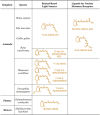Retina, retinol, retinal and the natural history of vitamin A as a light sensor
- PMID: 23363998
- PMCID: PMC3546623
- DOI: 10.3390/nu4122069
Retina, retinol, retinal and the natural history of vitamin A as a light sensor
Abstract
Light is both the ultimate energy source for most organisms and a rich information source. Vitamin A-based chromophore was initially used in harvesting light energy, but has become the most widely used light sensor throughout evolution from unicellular to multicellular organisms. Vitamin A-based photoreceptor proteins are called opsins and have been used for billions of years for sensing light for vision or the equivalent of vision. All vitamin A-based light sensors for vision in the animal kingdom are G-protein coupled receptors, while those in unicellular organisms are light-gated channels. This first major switch in evolution was followed by two other major changes: the switch from bistable to monostable pigments for vision and the expansion of vitamin A's biological functions. Vitamin A's new functions such as regulating cell growth and differentiation from embryogenesis to adult are associated with increased toxicity with its random diffusion. In contrast to bistable pigments which can be regenerated by light, monostable pigments depend on complex enzymatic cycles for regeneration after every photoisomerization event. Here we discuss vitamin A functions and transport in the context of the natural history of vitamin A-based light sensors and propose that the expanding functions of vitamin A and the choice of monostable pigments are the likely evolutionary driving forces for precise, efficient, and sustained vitamin A transport.
Figures




References
-
- Brine D.T., Iqbal M. Diffuse and global solar spectral irradiance under cloudless skies. Sol. Energy. 1983;30:447–453. doi: 10.1016/0038-092X(83)90115-9. - DOI
-
- Lean J. Evolution of the sun’s spectral irradiance since the maunder minimum. Geophys. Res. Lett. 2000;27:2425–2428. doi: 10.1029/2000GL000043. - DOI
-
- Nathans J., Piantanida T.P., Eddy R.L., Shows T.B., Hogness D.S. Molecular genetics of inherited variation in human color vision. Science. 1986;232:203–210. - PubMed
Publication types
MeSH terms
Substances
Grants and funding
LinkOut - more resources
Full Text Sources
Medical

